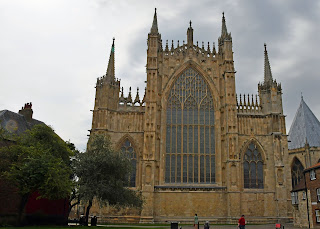Work commenced on Hadrian's wall in 122 AD under the direction of the Roman Emperor Hadrian, the wall took 15,000 men and 6 years to build. The wall was designed to act as an imposing statement of the empire's power as well as a deterrent. The wall was an impressive 73 miles long. Only 10% of the wall is still visible today. The day we visited we met a group of people that were on an 11-day, 85-mile hiking tour of the wall. Their bags were carried by their tour company and they stayed at various Bed and Breakfast locations along the way as they hiked the path where the wall once stood.
We have had wonderful weather on this trip. York, England was the first place on this trip when we encountered rain, which is pretty unusual for the British Islands. And the rain we did encounter was fairly short-lived, 45 minutes maybe.
The York Shambles, originally a word for a slaughterhouse, is a maze of twisting narrow cobbled streets in York where well-preserved buildings from 1350-1475 remain. For centuries, this was the street of butchers and also the main place where the locals came to buy their meat. Walking down this street we could still see the hooks that were used to display the meat. The street overhanging upper floors not only provided for great upper floor space without intruding on the street below, but it is said to have been done to lower the taxes that one paid on their property too, as those were determined by the actual ground footprint of the building. Although as recently as 1872 there were 26 butcher shops on the street, today no butcher shops remain and the shops mainly cater to tourist interests.
The earliest part of All Saints Pavement Church is the nave that dates back to the 12th century. The first known mention of the church is in the Doomsday Book (the year 1086). It is the burial place of 34 Lord Mayors. This church tower, in medieval times, was lit at night with a lantern to help guide travelers into the city from the wolf infested Forest of Galtres. The 14th Century West window depicts the Passion and Resurrection of Christ.
York Minster is one of the largest cathedrals in all of England. While a wooden church first stood at the site in 627, the church that is seen today was built over a period of 250 years from 1220 - 1472. York Minster houses the greatest collection of intact medieval stained glass in the world. The large Minster is 524 ft. X 249ft. and the interior of the main cathedral is the height of an 8 story building.
We were disappointed that being a Sunday, we were unable to take their extensive tour of this unique treasure. Several of us in our group, however, decided to attend one of their services with the idea that it would afford us some view of the inside. Since we arrived well after the service had begun, we sat outside of the sanctuary in an overflow area (still stunning) known as the East End. While we were unable to tour the entire Cathedral, we were treated to some of the most beautiful music during the service. If we have the opportunity to return one day, while touring the entire cathedral will be high on our list, so will attending another service. The choir mixed with the incredible acoustics within were simply unbelievable. The sounds of the choir quickly dampened our initial disappointment of not being able to tour the cathedral. I just closed my eyes and took it all in. While this link will not give you the full experience, here is a short clip of the talented choir that we experienced. York Minster Choir
Jedburgh Abbey Jedburgh, Scotland This Bee was Tiny, No More Than 1/4" Long Jedburgh Abbey Jedburgh, Scotland Church of Scotland Jedburgh Old and Trinity Parish Jedburgh, Scotland Hadrian's Wall Brampton, England The Shambles York, England All Saints Pavement Church York, England All Saints Pavement Church York, England The East Window (the year 1370) All Saints Pavement Church York, England York Minster York, England The East End York Minster York, England Back Side of York Minster York, England |











No comments:
Post a Comment